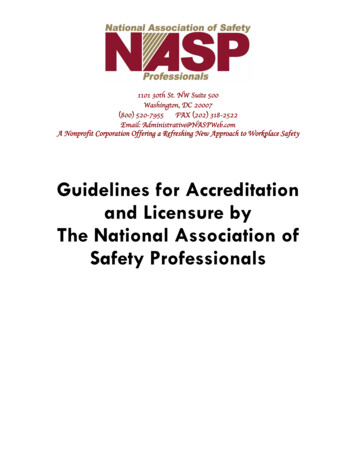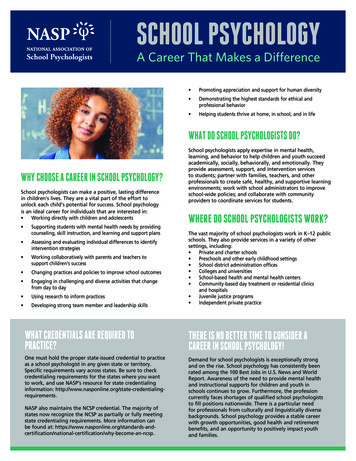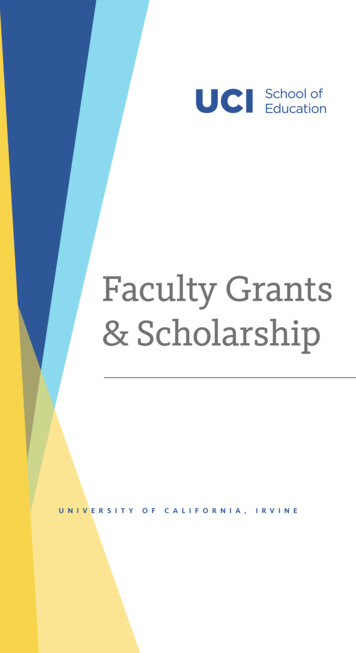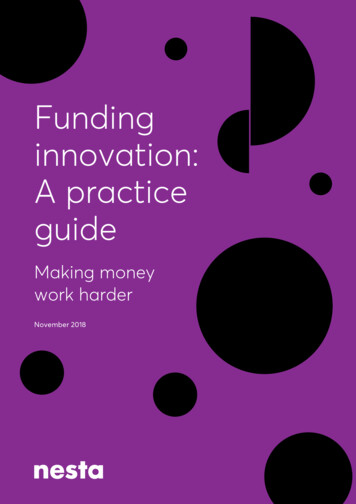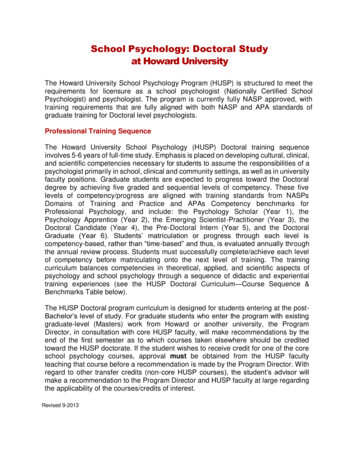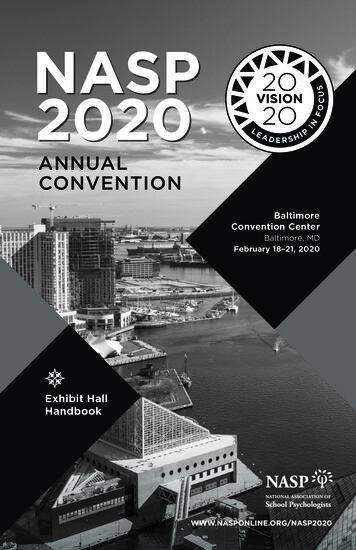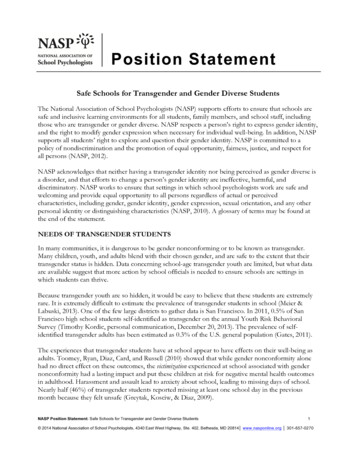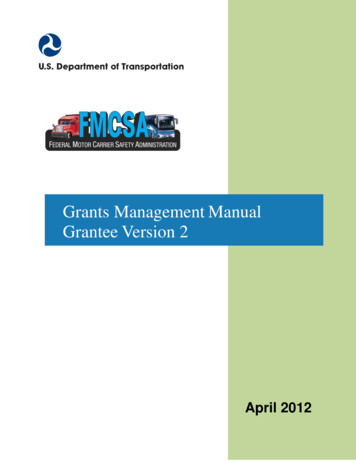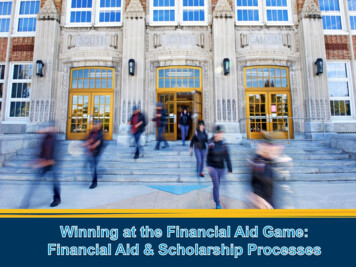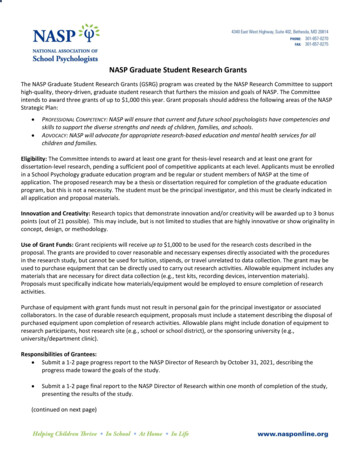
Transcription
NASP Graduate Student Research GrantsThe NASP Graduate Student Research Grants (GSRG) program was created by the NASP Research Committee to supporthigh-quality, theory-driven, graduate student research that furthers the mission and goals of NASP. The Committeeintends to award three grants of up to 1,000 this year. Grant proposals should address the following areas of the NASPStrategic Plan: PROFESSIONAL COMPETENCY: NASP will ensure that current and future school psychologists have competencies andskills to support the diverse strengths and needs of children, families, and schools.ADVOCACY: NASP will advocate for appropriate research-based education and mental health services for allchildren and families.Eligibility: The Committee intends to award at least one grant for thesis-level research and at least one grant fordissertation-level research, pending a sufficient pool of competitive applicants at each level. Applicants must be enrolledin a School Psychology graduate education program and be regular or student members of NASP at the time ofapplication. The proposed research may be a thesis or dissertation required for completion of the graduate educationprogram, but this is not a necessity. The student must be the principal investigator, and this must be clearly indicated inall application and proposal materials.Innovation and Creativity: Research topics that demonstrate innovation and/or creativity will be awarded up to 3 bonuspoints (out of 21 possible). This may include, but is not limited to studies that are highly innovative or show originality inconcept, design, or methodology.Use of Grant Funds: Grant recipients will receive up to 1,000 to be used for the research costs described in theproposal. The grants are provided to cover reasonable and necessary expenses directly associated with the proceduresin the research study, but cannot be used for tuition, stipends, or travel unrelated to data collection. The grant may beused to purchase equipment that can be directly used to carry out research activities. Allowable equipment includes anymaterials that are necessary for direct data collection (e.g., test kits, recording devices, intervention materials).Proposals must specifically indicate how materials/equipment would be employed to ensure completion of researchactivities.Purchase of equipment with grant funds must not result in personal gain for the principal investigator or associatedcollaborators. In the case of durable research equipment, proposals must include a statement describing the disposal ofpurchased equipment upon completion of research activities. Allowable plans might include donation of equipment toresearch participants, host research site (e.g., school or school district), or the sponsoring university (e.g.,university/department clinic).Responsibilities of Grantees: Submit a 1-2 page progress report to the NASP Director of Research by October 31, 2021, describing theprogress made toward the goals of the study. Submit a 1-2 page final report to the NASP Director of Research within one month of completion of the study,presenting the results of the study.(continued on next page)
Submit a presentation proposal for a NASP Convention within 2 years of receiving the grant. The conventionregistration fee will be reimbursed to grant recipients at the student rate, should their presentation proposal beaccepted for the convention. If a grant recipient is no longer a student, an amount equivalent to the studentregistration fee will be reimbursed, with the grant recipient responsible for the balance. Submit a summary of their research to be considered for publication in Communiqué. Students will beresponsible to communicate with the editor of Communiqué regarding submission procedures.Review Process and Timeline: GSRG proposals will be reviewed in two steps. First, 3-person subcommittees of the NASPResearch Committee will review proposals. The most highly ranked proposals will then undergo a second-step review bya separate 3-person subcommittee. Each subcommittee will consist of members of Research Committee, as well as onestudent reviewer. Up to two grantees will be chosen from those proposals undergoing the second-step review. TheCommittee’s rating form is included at the end of this document. Grantees will be notified via email no later thanDecember 1, 2020.APPLICATION INSTRUCTIONSRequired Application Materials:1. Demographic Information Form (signed by your program coordinator/director; see the form at the end of thisdocument.)2. Letter of Application (not more than one double-spaced page describing one’s research interests, experiences,and career plans)3. Curriculum Vitae4. Research proposal (see requirements below)Research Proposal Requirements: The proposal narrative must include the following elements: (a) title page, (b) introduction (c) explanation of thepurpose for the project, including reference to relevant research literature and theory, (d) research questionsand hypotheses, (e) methodology, (f) data analytic plan, (g) description of the study’s unique and substantivecontribution to the science and/or practice of school psychology, and (h) references. The proposal must follow the guidelines in the Publication Manual of the American Psychological Association (6thedition). The proposal narrative must be typed using a minimum 10-point font and be no longer than 6 double-spacedpages in length exclusive of the title page (and other appended forms/CV) and references.Applications that do not meet these proposal requirements will NOT be reviewed.Submitting Your Application:Completed applications must be submitted online as a single document. This must include the Demographic InformationForm, Letter of Application, Curriculum Vitae, Estimated Costs worksheet, and Research Proposal.Submit your application at this munity/grants/gsra/application.aspxApplication Deadline: 5:00 pm EDT, September 22, 2020. Incomplete applications or applications submitted after thisdeadline will not be reviewed.Questions? Contact Dr. Samuel Kim, Member, NASP Research Committee, at skim18@twu.edu.
NASP Graduate Student Research GrantsDemographic Information FormName:University:Year in Program:Degree Sought: MA/EdSPhDAddress:Telephone:Email:I attest that: Grant funds would not be used for tuition, stipends, or travel unrelated to data collection. Purchase of equipment (if applicable) will not result in personal gain for the principal investigator orassociated collaborators. If applicable, I have included a plan to dispose of purchased equipment upon completion of researchactivities (e.g., donation of equipment to research participants, host research site school/schooldistrict, or the sponsoring university). If funds are awarded for my proposal, I understand that I am responsible for any income tax liability tothe extent required by law.Student:(Signature)(Date)Program Director/Coordinator:(Printed Name)(Signature)(Date)
NASP Graduate Student Research Grants - Scoring RubricStudentQualificationsto Carry outProject(1-page letter CV)Purpose andObjectives ofResearchProposedDesign &MethodsEXEMPLARY(3 PTS.)Researchexperiences andinterests clearlysuggest thestudent couldcarry out theproposed project.The researchenvironment andavailableresources suggesta good chance ofachieving statedresearch goals.Purpose of thestudy is basedupon review ofrelevant literature.Presents a wellstructured, logicalargument for thepurpose of thestudy. Specifictestable researchquestion(s) arestated.Design relevant topurpose of studyand appropriate toanswer researchquestions. Use ofqualitative vs.quantitative vs.single-subjectdesign is justified.Study proceduresare clearlyspecified and inaccordance withwell-establishedresearch methods.Measures (whenapplicable) areappropriate andhavepsychometricsupport.Limitations todesign areminimized asmuch as possible.ADEQUATE(2 PTS.)Student’s researchinterests andexperiencessuggest they couldlikely carry out theproject.The availableresearchenvironment orresources needed tocarry out studymay bequestionable.Purpose of thestudy is based uponreview of literature,but relevantsources may bemissing. Presentsan argument for thepurpose of study.Clear question(s),but may beuntestable asstated.Design is clear andprocedures seem inaccordance withwell-establishedresearch methods,but may be lackingin detail or notfully specified.Measures (whenapplicable) arerelevant, but lackpsychometricsupport (e.g.,student-createdmeasures orsurveys).NEEDSIMPROVEMENT(1 PT.)Student has limitedresearch backgroundor experiences to carryout the proposedproject, or it is toocomplex for theperson’s level ofexperience andresearch training.MISSING(0 PTS.)Researchinterests,experiences notdelineated.Literature is reviewed,but it does not lead toa structured argumentfor the purpose of theresearch study. Vague,untestable researchquestion(s).No review ofpertinentliterature.No researchquestions posed.Procedures are fatallyflawed such that thedesign does not allowfor valid orappropriateconclusions to bedrawn.Details on designor procedures aremissing or solacking in detailthat it is unclearwhat the studywould involve.Measures (whenapplicable) arepsychometricallyflawed orinappropriate toanswer the proposedresearch question(s).Details onmeasures (whenapplicable) aremissing or solacking in detailthat it is unclearwhat measureswould be used.SCOREREVIEWERCOMMENTS
Participants/SelectionData AnalysesEXEMPLARY(3 PTS.)Sampling plan issufficient to resultin generalizableknowledge forgroup designs(e.g., a prioripower analysisverifies proposedsample size), or toestablish stronginternal validityfor single casedesigns (e.g., atleast 3 cases for amultiple baselinedesign), or areappropriate to thephenomenonstudied forqualitativedesigns.ADEQUATE(2 PTS.)Procedures forparticipantrecruitment &selection areappropriate ðical. Samplesize may be toosmall or restrictedto allow forgeneralization.Quantitative, largen designsminimize majorthreats to externalvalidity, andappropriatestatistical analysesare proposed toanswer the statedresearchquestion(s).Single-subject,small n designsminimize majorthreats to internalvalidity, and aplan for visualanalysis is clearlyoutlined.Qualitativedesignsinclude a plan forgenerating andinterpretingthemes, andstrategies forreducingresearcher biasand/or validatingfindings.Proposed dataanalyses areappropriate andconsistent withstated question(s),but some designlimitations orthreats to validitymay not beacknowledged orminimized fully.NEEDSIMPROVEMENT(1 PT.)Sampling plan isinsufficient to achievethe scientific goals ofthe research.Weak, flawed, orunorganizedexplanation of dataanalyses, whichprevents one fromconcluding that theresearch question(s)can be answered.MISSING(0 PTS.)No participantrecruitment orsampling plan isgiven.No informationgiven regardinghow data will beanalyzed/conclusionsdrawnSCOREREVIEWERCOMMENTS
Significanceof (3 PTS.)Presentscompellingjustification forthe significance ofthe research usingwell-structured,logical argument.Strong likelihoodthat results couldbe publishable inpeer-reviewedjournal. Addressesan importantquestion whoseanswer will haveuseful outcomes.ADEQUATE(2 PTS.)Shows some effortto presentjustification forsignificance ofresearch usingwell-structuredargument.Likelihood offuture publicationpossible.Uses acceptablespelling, style,and grammar (fewor no errors).Writing is clear,organized, andsuccinct.Uses adequate styleand grammar, butmay have sometypos. Proposal isunderstandable, butcould be moreorganized orconcise.Study is highlyinnovative and/ororiginal inconcept, design,or methodology.Strong rationale forstudy, but proposedconcept, design, ormethodology arenot particularlyinnovative ororiginal.NEEDSIMPROVEMENT(1 PT.)Weak, unstructuredargument justifyingthe significance of theresearch. Little to noevidence that results ofthis study will add tothe science or practiceof school psychology.Fails to use acceptablestyle and grammar inthat there are severalspelling/grammaticalerrors OR writinglacks organization andclarity making itdifficult to understandintent.Reasonable question,but a replication studyor will add little to theliterature based in thistopic area.MISSING(0 PTS.)Significance ofproposed worknot articulated.Serious spelling,style, and/orgrammar flaws.Writing isincoherent orsignificantlydisorganized.Seriousconceptual ormethodologicalflaws.Total Score:(out of 21possible pts.)Other General Comments or Suggestions for the Student Researcher (optional):SCOREREVIEWERCOMMENTS
in a School Psychology graduate education program and be regular or student members of NASP at the time of application. The proposed research may be a thesis or dissertation required for completion of the graduate education program, but this is not a necessity. . Member, NASP Research Committee, at skim18@twu.edu. NASP Graduate Student .
